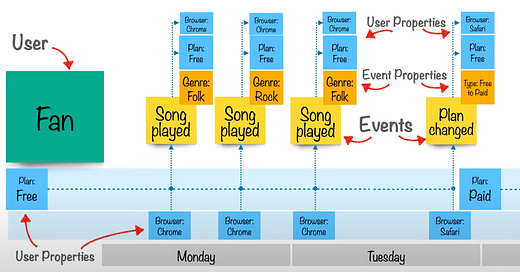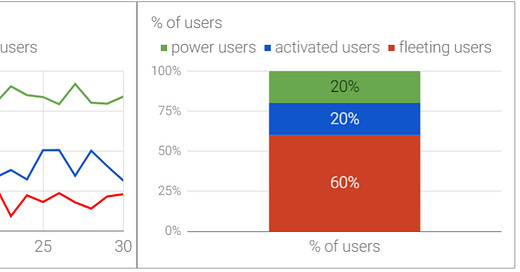

Discover more from Data Analysis Journal
Engagement and Retention, Part 2: Daily Active Users - Issue 85
An introduction to user activity analytics - how to monitor and report user engagement to best drive and scale growth.
Today’s newsletter is a continuation of the User Engagement and Retention series with a focus on Daily or Monthly Active User metrics reporting. I’ll talk through how to define active users, what events to use, which activity frequencies to follow, and how to approach engagement analytics for weekly and monthly reporting.
To recap, user engagement and retention are accelerators of product growth. Any improvement in engagement and retention returns an improvement in the acquisition, virality, and monetization. The more insight on user activity you get, the more precisely you can tailor marketing and business strategies.
There are 3 main components of user retention:
Activation
Engagement
Resurrection
I covered the introduction into each of these (as well as retention overall) in my Engagement and Retention. The Sticky Situation issue. Today I want to break down Retention Component #2: Engagement.
Engagement 101
Engagement is a broad domain where every KPI is meant to illustrate how often or how well users interact with a product. I put together a list of all Product KPIs here. These are common engagement KPIs across many companies, small or large:
MAU, WAU, DAU,
DAU/MAU ratio,
Day 0, Day 1+, Day 7+ and Day 28 retention,
% 1-year or 2-year retention,
A number of Returning Users,
Daily/Hourly Number of Actions,
Total Watch Time,
Total Time Spent,
Frequency of Visits,
Pages Per Session/Visit,
Scroll Depth,
Average Session/Visit Duration,
Exit Rate / Exit Page,
Product Abandonment Rate, others.
Depending on the company strategy and the product type, some of these are usually important KPIs and top-level metrics, like MAU, DAU, DAU/MAU ratio, Day 1+ and Day 7+ Retention. Others are common secondary metrics and are used to measure experimentation success, feature rollouts, and bug fixes.
DAU or MAU is the most common and important engagement metric. Measuring the total number of active users might sound simple at first, but once you get into all of the data, this task becomes less straightforward.
There are 2 big common challenges analysts face with active users:
What is “active”?
What frequency of activity is appropriate for KPIs reporting - DAU, WAU, MAU?
Let’s break down each challenge.
What is “active”?
As I pointed out earlier, the easiest definition of “active” often becomes the hardest challenge to define and extract.
Here are the most common events used for the “active” user definition across many companies:
Visit
Session starts
Login / app open
Web page view/screen view
The main user activity (item view, search, exercise log, transaction, etc).
Each of these events has its own downsides and limitations to be used for DAU reporting:
Visit - too broad, you will overcount users, most likely having a challenge with unauthenticated and not registered users. Only relevant for the website.
Session starts - you’ll possibly overcount users by pulling in unauthenticated IDs.
Login/app opens - same as above, as you will need a way to exclude new users with their first app open event, exclude not authenticated users and duplicates.
Web page views/screen views - too broad, most likely will pull in all user types (dormant, lapsers, new users) and over-report active users.
The main user activity (item view, search, exercise log, transaction, etc) - too narrow, easy to miss active users who don’t do the main activity you expect, but keep using the app (for example, the Adjacent Users case).
As an analyst, you also should consider another aspect of DAU reporting: the definition you end up with (either login or app open) should not only be the same across your devices and platforms (if you support mobile and web) but also across multiple data sources you use for analytics (client data / the backend or server-side data). Sometimes you are stuck with only a few events that you can trust and don’t have the opportunity to pick the right event.
At different companies, I had to report DAU based on all these event variations, sometimes even mixing a few of them together (session start + app open + main transaction). Using Logins or App opens is the most common approach today at many companies.
Given that I always aim for the cleanest and most precise data reporting, my favorite DAU event is the main user activity. I’d ignore all the “noise” events like visits, screen views, and logins, and tailor KPI to only the main transaction or event that you expect a user most commonly does. Yes, your DAU count will be lower but will also give you the cleanest sample of truly Active users whose behavior you can control and validate. Also, based on my experience, the main user action is usually available across all platforms (unlike app open or visits) and data sources.
Frequency of user activity
The most common question from analysts and PMs: what engagement KPI is the best to use for weekly/monthly reporting: DAU, WAU, or MAU? What’s the most reliable way to know the right and appropriate user frequency of product usage?
You have to consider product vision and data to answer it:
Product vision - think of your product usage and vision. How often do you expect your user to use a product? Once per week? Daily? Hourly? How often do you expect (and want) users to log an exercise or food? To send a message? To view an item?
Social network companies monitor Hourly Active Users or even Active Users per Minute. There is a rule of thumb if your product is an app and falls into the social, search, or browser category, you should expect at least daily activity, if not hourly. If your product is a website, you could fall into the Weekly or Monthly category (also common for travel, dating, or payments apps).
Now, let’s quantify it - run Activity Histogram Analysis. SQL attached. See what is the current product usage and go from there. See how many you have HAU (Hourly Active User) and if the number makes sense to scale up. Check the total number of daily sessions or logins per user. If the number is high, this is your KPI.
Additionally, pull DAU/WAU ratio and DAU/MAU ratio metrics. This will show you what % of Monthly or Weekly Active Users use your product Daily. The highest ratio has the right frequency.
If confused, follow this guide:
If DAU/WAU ratio is 60% or higher, it means that users use the product more than 4 days a week, and you have to follow DAU reporting and not WAU.
If WAU/MAU ratio is 60% or higher, it means that users use the product more than 2 or 3 times per month, and you have to follow WAU reporting and not MAU.
Therefore, here is your set of engagement KPIs:
DAU, WAU, or MAU (pick one. If the product is used daily, it’s also used weekly or monthly).
DAU / MAU ratio or DAU / WAU ratio
Day 1+, Day 7+ or Day 30+ retention
Thanks for reading, everyone. Until next Wednesday!
Related publications:
Subscribe to Data Analysis Journal
Where product, data science, and analytics intersect. Trusted by tens of thousands of data scientists around the world













